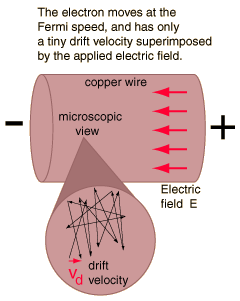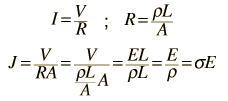When electric current in a material is proportional to the voltage across it, the material is said to be "ohmic", or to obey Ohm's law. A microscopic view suggests that this proportionality comes from the fact that an applied electric field superimposes a small drift velocity on the free electrons in a metal. For ordinary currents, this drift velocity is on the order of millimeters per second in contrast to the speeds of the electrons themselves which are on the order of a million meters per second. Even the electron speeds are themselves small compared to the speed of transmission of an electrical signal down a wire, which is on the order of the speed of light, 300 million meters per second.

The current density (electric current per unit area, J=I/A) can be expressed in terms of the free electron density as

The number of atoms per unit volume (and the number free electrons for atoms like copper that have one free electron per atom) is

From the standard form of Ohm's law and resistance in terms of resistivity:

The next step is to relate the drift velocity to the electron speed, which can be approximated by the Fermi speed:
|

The conductivity of the material can be expressed in terms of the Fermi speed and the mean free path of an electron in the metal.
 |
Fuente: http://hyperphysics.phy-astr.gsu.edu/hbase/electric/ohmmic.html
Nombre: Rodriguez B. Joiver I.
Asignatura: CRF
Nombre: Rodriguez B. Joiver I.
Asignatura: CRF

No hay comentarios:
Publicar un comentario